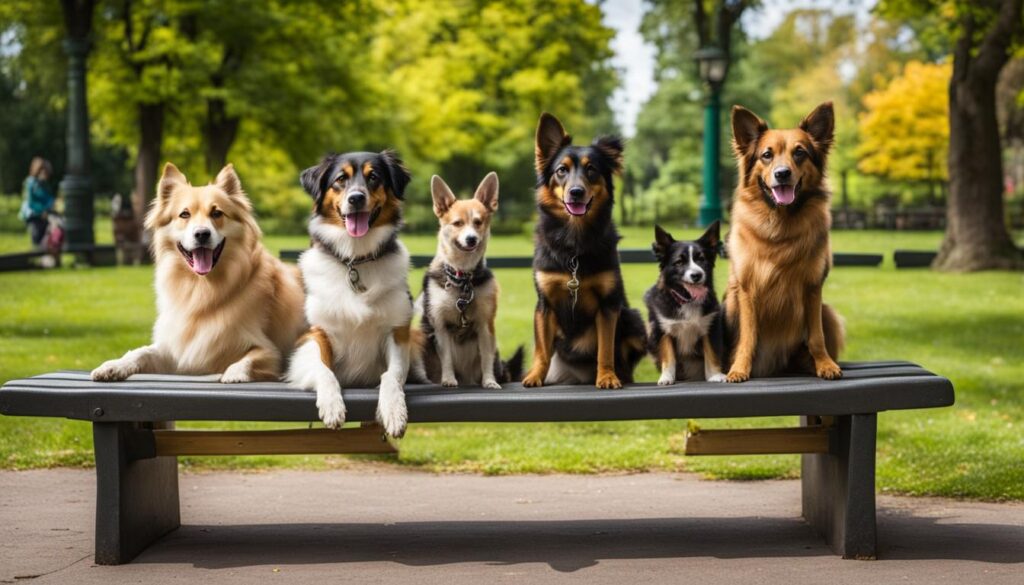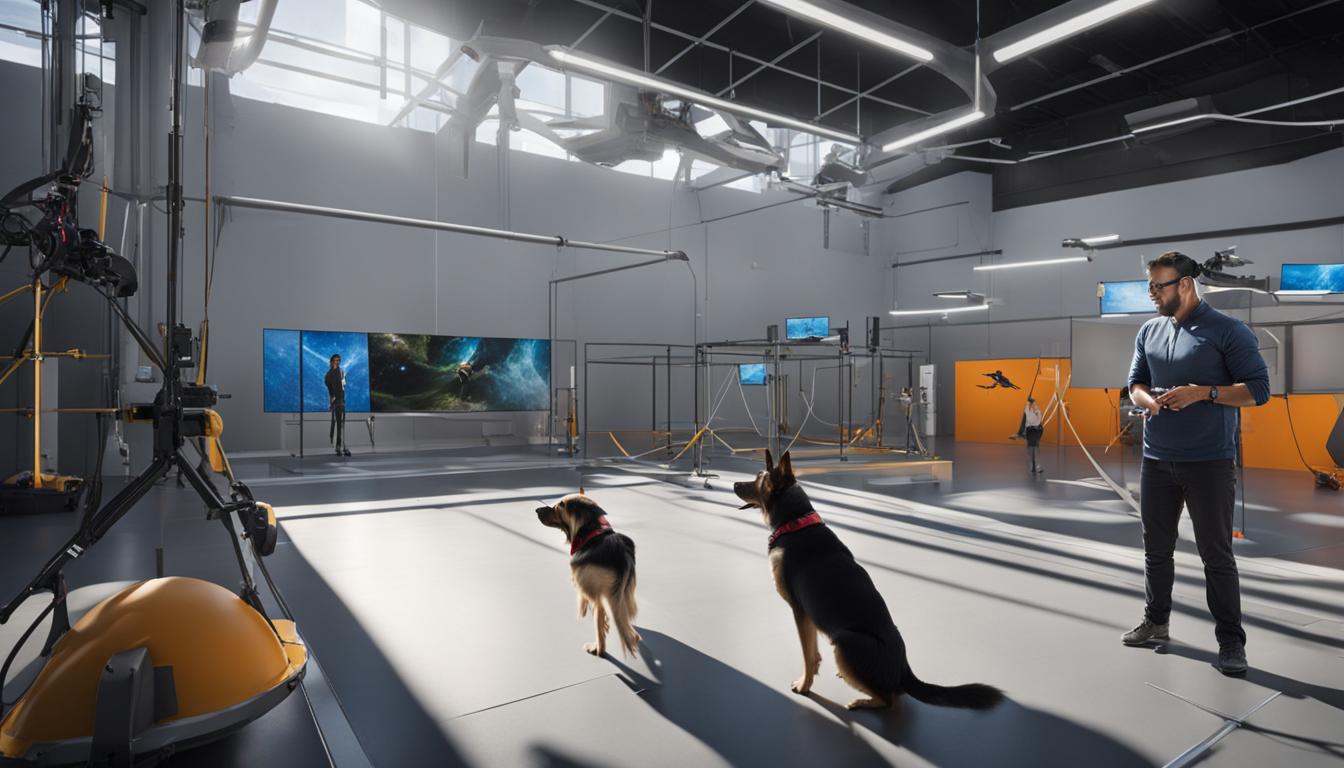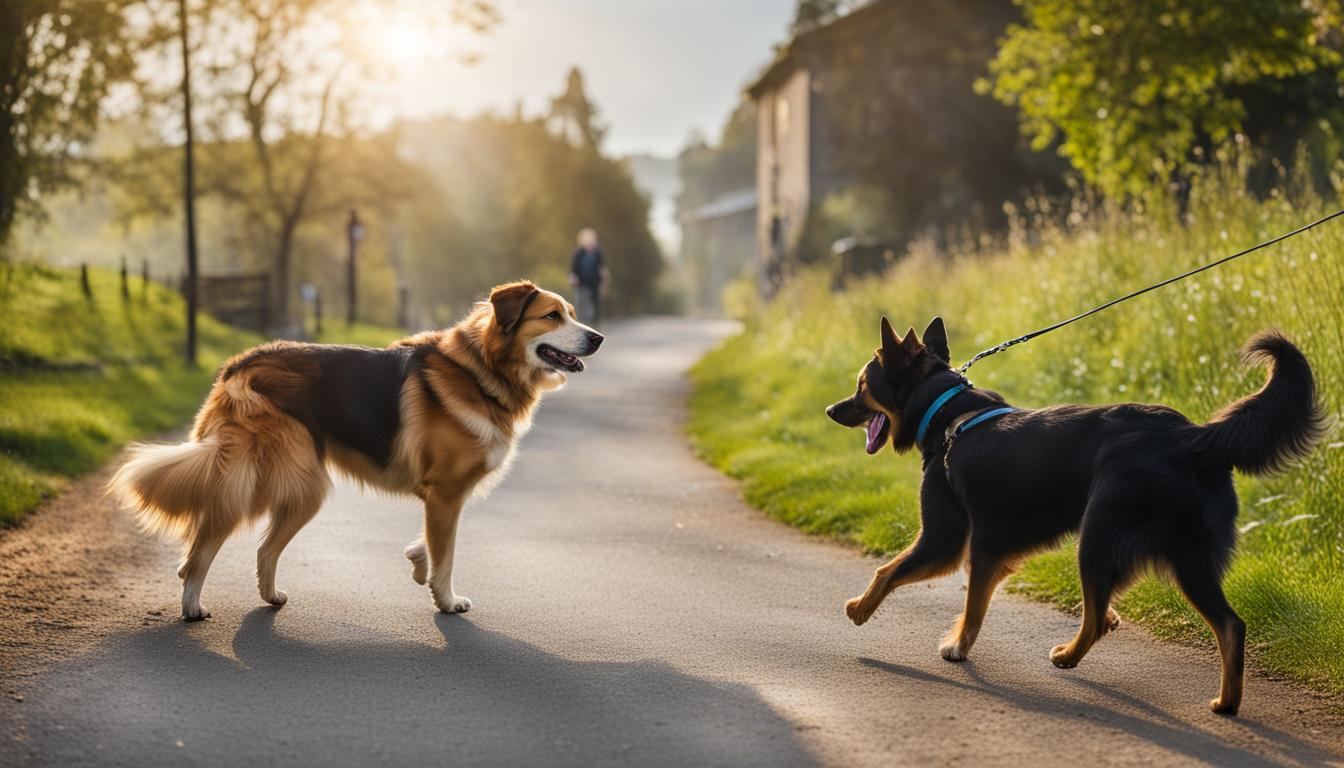Are you the proud owner of a shy or fearful dog? Adopting these gentle souls can be incredibly rewarding, but it also comes with unique challenges. Shelters, pet stores, and irresponsible breeders often have timid dogs in need of socialization. Understanding their needs and providing the right environment is crucial for their well-being and rehabilitation.
Key Takeaways:
- Shy dogs require patience, understanding, and a tailored approach to socialization.
- Building trust and confidence is crucial for their rehabilitation and well-being.
- Recognize and respect their fears, allowing them to set the pace of interactions.
- Creating safe spaces, managing interactions, and providing structure are proven techniques for helping shy dogs.
- Each dog is unique and may have different needs and timelines for rehabilitation.
Understanding Shy Dog Breeds and Personalities
When working with a shy dog, it is important to consider the breed tendencies and individual personalities that can contribute to their shyness. Some dog breeds are naturally more introverted and prone to shyness, while others may have had negative experiences in the past that have shaped their behavior. Understanding these factors can help you tailor your approach to socializing and building trust with your shy dog.
Shy dog breeds, such as the Basenji, Chow Chow, and Shetland Sheepdog, are known for their reserved and cautious nature. These dogs may require more time and patience to adjust to new people, animals, or environments. On the other hand, breeds like the Golden Retriever or Labrador Retriever are generally more outgoing and sociable. However, it is important to note that individual personalities within a breed can vary, so it is essential to consider your dog’s specific needs and preferences.
It is crucial to recognize that shyness in dogs is not always a problem that needs to be “fixed.” Some owners may prefer introverted dogs and appreciate their calm and gentle nature. However, it is important to provide all dogs, including shy ones, with appropriate social interaction and training to ensure their overall well-being. It is not about changing their basic nature, but rather helping them navigate the world with confidence.
Understanding your shy dog’s breed tendencies and individual personality can guide you in creating a safe and supportive environment for their socialization journey. By acknowledging and respecting their natural inclination towards shyness, you can take the necessary steps to help them feel more comfortable and build their confidence over time.
Table: Shy Dog Breeds
| Breed | Temperament |
|---|---|
| Basenji | Sensitive, Independent |
| Chow Chow | Aloof, Reserved |
| Shetland Sheepdog | Gentle, Timid |
| Golden Retriever | Sociable, Friendly |
| Labrador Retriever | Outgoing, Energetic |
Quotes:
“Understanding these factors can help you tailor your approach to socializing and building trust with your shy dog.”
“It is important to provide all dogs, including shy ones, with appropriate social interaction and training to ensure their overall well-being.”
“By acknowledging and respecting their natural inclination towards shyness, you can take the necessary steps to help them feel more comfortable and build their confidence over time.”
Fearful Dog Socialization: Tips for Building Confidence and Trust
If you have a shy or fearful dog, socializing them can be a challenging but rewarding journey. By following these tips, you can help your furry friend feel more comfortable and confident in social settings.
Creating a Safe Space for Shy Dogs
First and foremost, it’s important to create a safe and secure environment for your shy dog. This includes providing a designated space where they can retreat to when they feel overwhelmed. Make sure this space is quiet, comfortable, and free from any potential triggers that may cause anxiety or fear. Adding familiar and comforting items like their bed, toys, and blankets can also help create a sense of security for them.
When introducing your dog to new people or environments, take things slow. Gradually expose them to new experiences in a controlled manner, allowing them to set the pace. This could involve starting with short outings to low-stress environments and gradually increasing the duration and complexity of the outings as your dog becomes more comfortable.
Managing Interactions with Shy Dogs
When socializing your shy dog, it’s important to manage their interactions with others. This means carefully selecting who they interact with and ensuring that the interactions are positive and stress-free. Start by introducing your dog to calm and well-behaved individuals who understand their needs and can provide a supportive environment.
When meeting new people or dogs, allow your shy dog to approach them at their own pace. Avoid forcing physical contact or overwhelming them with too much stimulation. Instead, use positive reinforcement techniques, such as treats and praise, to reward and encourage their social behavior. Over time, this will help build their confidence and trust.
Reward-Based Training and Controlled Socialization
Reward-based training is a highly effective method for socializing shy dogs. By using positive reinforcement, such as treats and praise, you can motivate your dog to engage in desired behaviors and help them associate social interactions with positive experiences.
Controlled socialization is also key to helping shy dogs overcome their fears. This involves gradually exposing them to different people, animals, and environments while ensuring they feel safe and supported. Working with professionals who specialize in shy dog behavior can provide valuable guidance and support throughout this process.
| Benefits of Reward-Based Training and Controlled Socialization for Shy Dogs | Examples of Techniques |
|---|---|
| Builds confidence and trust | Desensitization and counter-conditioning |
| Encourages positive associations with social interactions | Clicker training |
| Provides mental stimulation | Targeting and shaping |
| Strengthens the bond between dog and owner | Positive reinforcement for desired behaviors |
Remember, every shy dog is unique and may require different strategies and approaches. Be patient, understanding, and always prioritize your dog’s well-being. With time, effort, and a lot of love, you can help your shy dog overcome their fears and enjoy a happy, fulfilling life.

How to Help Your Shy Dog Feel Comfortable at Home
Creating a safe and secure environment at home is essential for helping your shy dog feel comfortable and secure. By providing them with a calm and quiet space that meets their needs, you can help alleviate their anxiety and build trust. Here are some tips to consider:
- Designate a specific area for your shy dog where they can retreat to when they feel overwhelmed. This area should be quiet, free from excessive foot traffic, and include their bed, toys, and other familiar items.
- Avoid direct eye contact and make slow, deliberate movements when interacting with your shy dog. This can help reduce their anxiety and make them feel more at ease.
- Get down on your dog’s level when interacting with them. This can help create a sense of trust and make them feel more comfortable.
- Allow your dog to approach and initiate interactions on their terms. Avoid crowding them or forcing physical contact as this can intensify their fear.
Remember, every shy dog is unique and may have different needs. Be patient and understanding as you work to create a safe and secure environment that helps your dog feel comfortable and secure at home.

Testimonials: Owners Share Their Tips
“Creating a quiet space with all her favorite toys and a cozy bed made a world of difference for my shy dog. She now has a safe haven where she can relax and feel secure.”
“Being patient and giving my shy dog space to come to me has been crucial in building her trust. It’s amazing to see her confidence grow as she feels more secure in our home.”
| Tips for Helping Shy Dogs Feel Comfortable at Home |
|---|
| Designate a calm and quiet area for your dog with familiar items. |
| Avoid direct eye contact and make slow, deliberate movements. |
| Get down on your dog’s level when interacting with them. |
| Allow your dog to approach and initiate interactions on their terms. |
Understanding a Shy Dog’s Perspective
When it comes to helping shy dogs, it’s essential to put yourself in their paws and see the world from their perspective. These dogs have often experienced trauma or lacked proper socialization, leading to fear and anxiety in new situations. By practicing empathy and understanding, we can create a safe and supportive environment that helps these dogs thrive.
One key aspect of understanding a shy dog’s perspective is recognizing and respecting their fears. What may seem harmless to us could be overwhelming for them. By observing their body language and reactions, we can identify triggers and avoid putting them in stressful situations. It’s important to give shy dogs the time and space they need to feel comfortable and build trust.
“Shy dogs need patience, compassion, and a gentle approach,” says Dr. Lisa Johnson, a renowned animal behaviorist. “Their past experiences have shaped their behavior, and it’s our job to help them overcome their fears and develop confidence.”
Caring for shelter dogs requires a deep understanding of their unique backgrounds and experiences. Many of these dogs have been abandoned or mistreated, leading to a heightened sense of fear and mistrust. Creating a safe and secure environment for them is paramount. Providing a quiet space, regular routines, and positive reinforcement can help alleviate anxiety and build their confidence.
| Benefits of Understanding a Shy Dog’s Perspective | Tips for Empathy and Care |
|---|---|
|
|
By seeing the world from a shy dog’s perspective, we can make informed decisions that prioritize their well-being. Through empathy, patience, and dedicated care, we can help these dogs overcome their fears, build confidence, and lead happy, fulfilling lives in loving homes.

Conclusion
Socializing a shy dog can be a fulfilling and rewarding journey. With patience, understanding, and the right techniques, you can help your timid canine overcome their shyness and build trust. Remember, each dog is unique, so it’s important to tailor your approach to their individual needs.
Creating a safe and secure environment is key to helping a shy dog feel comfortable. Designate a calm and quiet space in your home where they can retreat when they need some alone time. Avoid overwhelming stimuli and provide them with all their necessities to promote a sense of security.
Managing interactions is crucial when socializing a shy dog. Take things slow and give your furry friend control over their interactions. Identify their triggers and work to minimize fear reactions. Reward-based training and controlled socialization can also be effective in building their confidence.
Remember, overcoming shyness in dogs takes time. Be patient, understanding, and consistent in your efforts. With your dedication and a supportive environment, your shy dog can flourish and lead a happy, fulfilling life. Building trust and socializing your timid canine can create a strong bond that will last a lifetime.
FAQ
What should I expect when adopting a shy dog?
Shy dogs may require more socialization and behavior modification to build confidence and trust. It’s important to understand the challenges and provide a calm environment for their rehabilitation.
Are some dog breeds naturally shyer than others?
Yes, certain breeds tend to be shyer than others. Understanding breed tendencies can help when working with a shy dog. However, all dogs need social interaction to thrive.
How can I socialize a shy dog?
Take things slow and give the dog control over interactions. Identify triggers and manage interactions accordingly. Reward-based training and controlled socialization can be beneficial. Working with professionals who have experience with shy dogs can provide additional support.
What can I do to help my shy dog feel comfortable at home?
Create a calm and quiet space with all their necessities. Avoid direct eye contact, make slow movements, and get down on the dog’s level. Allow the dog to approach and initiate interactions, avoiding crowding or forcing physical contact.
How can I understand the world from a shy dog’s perspective?
Recognize and respect their fears, allowing them to set the pace of interactions. Provide a safe and secure environment, avoid overwhelming stimuli, and understand the impact of trauma or lack of socialization.
What do I need to know about socializing a shy dog?
It requires patience, understanding, and a tailored approach. Using proven techniques such as creating safe spaces, managing interactions, and providing structure can help shy dogs gain confidence and trust.





